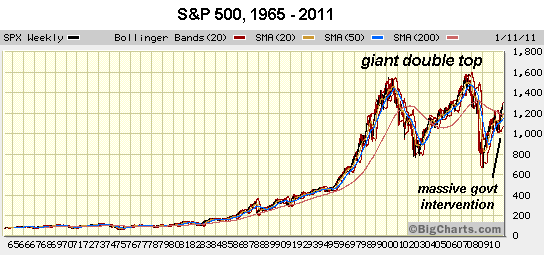The Turning Point
Some technical analysts are calling for a major rally from here, but the massive injections of financial insulin don't seem to be reviving the sagging global economy. The stock market and economy are both at a turning point. Analyst Martin Armstrong's Economic Confidence Model (tm) set the turn date as June 13/14, 2011. In the stock market, a number of technical analysts are issuing strong buys based on the negative sentiment of so-called "dumb money"--small investors--and the number of stocks below their 50-day moving averages. Others such as Armstrong are predicting that Greece has no alternative to default and the Euro is untenable as "one size does not fit all." It is rare to find a market where the technical evidence is so compelling for a strong rally yet the fundamental basis for such a rally so lacking. Exactly where do Bulls think the growth and rising profits are going to come from? The answer for the past few years has been massive Federal Reserve/Federal intervention and stimulus, and a weakening U.S. dollar that boosted overseas profits via the legerdemaine of currency devaluation. But three years of these policies have accomplished nothing but load the taxpayer with staggering amounts of debt: none of the causes of the 2008 implosion have been fixed or even addressed. As Armstrong notes, the massive interventions did not shorten the crisis, they have prolonged it. This reality has filtered down to the political swamp, and now the politicos are hesitant to bet their own futures on additional trillions in stimulus and quantitative easing. For the first time in memory, the Federal Reserve is on the defensive. Simply put, its policies have failed to accomplish anything except prop up a rotten, insolvent banking sector that needs to be declared bankrupt and swept into the dustbin of history. As I have noted here before, the next round of QE (quantitative easing) will fail to inflate the stock market regardless of its size or tricks. The fact that QE3 is needed will spook everyone who understands that it is a last-ditch effort to keep the Status Quo financialization from imploding, and since QE2's sugar-high was so brief, others will be spooked by the possibility that the next high will be even shorter. This is the dreaded Diabetes Financial Syndrome--the Fed is pouring ever larger amounts of financial insulin into the system, but the financial "body" no longer responds to this insulin. The financial system then goes into toxic shock and implodes. Let's look at two charts for context. Here is the S&P 500 from 1965 to 2011. Hmm, are there any aberrations visible here, any gigantic spikes of speculative frenzy? Just because these spikes of speculative, financialized frenzy have been normalized doesn't mean they are no longer speculative, financialized frenzies. Has the economy really been healed? If not, then what is the basis of the market's spectacular rebound since 2009? We all know the answer: $6 trillion in Federal financial insulin and another $2 trillion in Federal Reserve insulin. The entire rally, in other words, is an artifact of Central bank/State intervention. Courtesy of dshort.com, here is an inflation-adjusted chart of the S&P 500. This chart clearly illustrates that unprecedented Central State stimulus and intervention/manipulation have juiced the market higher than previous post-crash highs. But the whole financial-insulin project is looking a bit long in tooth compared to previous post-crash markets. In the long run, perhaps we can attribute this extension of the euphoric high of "recovery" to the Fed's QE2, which pumped half a trillion dollars into stocks in a matter of months. Short of the Fed simply buying trillions of dollars in stocks outright, then it looks like this "recovery" rally is about to have a Wiley E. Coyote moment, as it has raced off the solid ground provided by the Fed's QE2 injections and is now poised in thin air. Of course the market could rally from here, but it's hard to see on what basis other than a technical dead-cat bounce. The Fed could announce another round of intervention, and that would certainly give the comatose body a jolt. But for how long? If it does respond to gravity, then we might want to re-visit the definition of "dumb money:" small investors have been pulling money out of the stock market all during the QE2 insulin-rush rally while the "smart money" has been piling in, blubbering piously about the key tenet of their religious faith, "don't fight the Fed." So which do you think is all-powerful, smart money--the Fed or gravity? We're about to find out. Of Two Minds Kindle edition: Of Two Minds blog-Kindle

Readers forum: DailyJava.net.
Order Survival+: Structuring Prosperity for Yourself and the Nation (free bits) (Mobi ebook) (Kindle) or Survival+ The Primer (Kindle) or Weblogs & New Media: Marketing in Crisis (free bits) (Kindle) or from your local bookseller.Thank you, Erle H. ($37.26), for your splendidly generous contribution to this site -- I am greatly honored by your support and readership. Thank you, Beth S. ($40), for your wondrously generous contribution via mail to this site-- I am greatly honored by your support and readership.



























